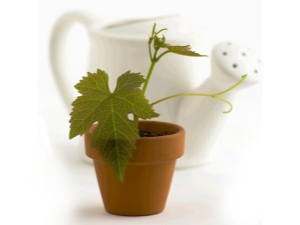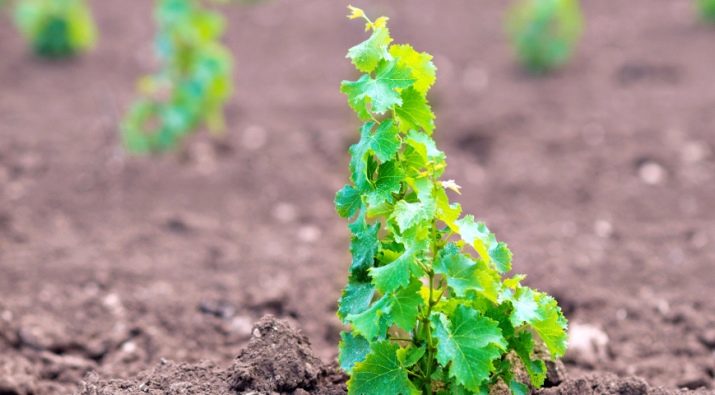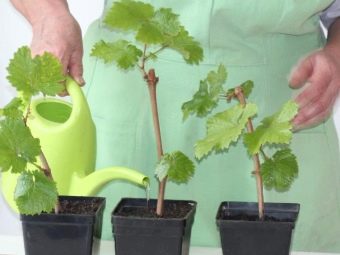How to grow grapes from the stone at home?

Grapes - one of the most popular cultivated plants.It successfully fulfills an aesthetic function, and gives very tasty berries that can be used fresh or processed in various ways. Most often, this plant is propagated either by seedlings or layering. However, here the material must be taken either from friends, in whom the choice of varieties may not be so large, or buy in a store where there is not always confidence in the result.
It is much more interesting to grow grapes from a stone, having previously tasted the berries - then you can sprout even the most delicious and expensive variety. Few people are engaged in growing grapes from seeds at home, but experienced gardeners say that it is difficult, but possible.
Specifics
Perhaps, it’s worth starting with disappointment - grapes grown from seeds often do not bear the same berries from which the planted grain is extracted. The best samples of wine berries are often a hybrid, but a sprout grown from a stone will have the advantages of only one of the varieties used for crossing.
For this reason, this method of growing the vine is not so much for the harvest, but for other purposes: breeding, the production of seedlings, the cultivation of the rootstock, as well as for purely decorative purposes. A tasty harvest, of course, is possible, but you should not count on it too much - probably, the taste will disappoint both by taste and by the number of berries.
It should be noted that not every variety is suitable for sprouting it from seeds - some will not germinate at all, while others will disappoint with the result. It is possible to try to grow a vine from a stone if an early variety of the hybrid type is planned. These include "Zephyr", "Laura", "Russian Concord", "Kesha-1" and "Delight", as well as some others.
When choosing, it is worth making a start on the reason why berries may be needed: sweet varieties are traditionally grown for eating, and sour is better for wine production.
When growing grapes at home, the risk of losing varietal properties is advised to bypass a fairly simple method, simply by planting several seeds at once. Probably, the individual sprouts will differ in different characteristics, therefore in the future it will be necessary only to compare the characteristics of young plants and to care more carefully for those that provide priority qualities.
Material preparation
No one ever lands in the ground not only the whole berry, but even just a newly extracted bone. Of course, in nature, plant reproduction can take place in this way, however, nature has thousands of seeds from each plant, and you will plant a maximum of several dozen at a time.
To increase the likelihood of a good result, it is worth carefully choosing the berries that give the stone - they must be large and must be ripe, without any visible shortcomings.
Seeds must be cleaned of pulp (in the ground it could provoke rotting) and washed well with cool water, as an option - soaked in it for a couple of hours. After that, you need to select the largest seeds, characterized by a bright brown or dark beige shade - this is a sign of maturity.
Theoretically, the planting can be carried out already at this stage, but in order to increase the chances of germination, it is also desirable to carry out a stratification. With a future landing directly into the ground, this process should start around December. The essence of the process is that the bones are wrapped in a damp cloth and packed in a bag of polyethylene, after which they are sent to the refrigerator for up to several months. At the optimum temperature within 0-3 degrees of heat, the outer shell of the grain will crack during this time - this is the end of stratification.
In the process, you should not forget to inspect the seeds every week and a half, and, if necessary, rinse them to prevent mold.
The stratified bones are laid on a cloth moistened with water. The temperature in the room should be quite high, while sheltering seeds is not supposed to - they should be freely ventilated. Within a few days, the bones will acquire small roots - and then it is time to plant them in open ground. At this point, quite warm weather is usually established on the street.
You can, of course, do without stratification - then the prepared kernels are simply sown in open ground before the onset of winter. TThis method is somewhat simpler, but the chances of germination of each individual grain are reduced. If, however, for planting also use the bones from the underdone fruits, the result will disappoint even more.
Growing in a pot
In the future, the matured plant can be planted at a country site, but in the early stages it should be carefully monitored, because many gardeners prefer to plant seeds first in the pot.
It should immediately be said that usually each grain is planted in a separate container, otherwise two potentially successful seedlings can simply interfere with each other.
The selected vessel must be provided with a drain hole in the bottom. The lower part of the pot is filled with small stones, and the earth is piled on top of them. For these purposes, you can use the soil, bought in a special store, but you can prepare it yourself - for this you need to take an equal amount of ordinary garden soil, sand and humus.
When the pot is filled with earth, it's time to plant a seed there. The optimum planting depth is about 1-1.5 cm, immediately after planting, the soil around the future plant should be poured with plenty of water, without creating swamps. It is important that until the emergence of the shoots the soil remains moistened, but this is achieved not by constant irrigation, but by covering the cups with any waterproof film.
Given that the grape is a southern plant, for its growth you need a large amount of light and heat. If the room has windows facing south, then there will be the optimal place for growing grapes from the stone. Normal conditions are considered to be a temperature not lower than +20 degrees in the daytime and not lower than +15 at night, then in a week or a half you can expect a sprout to appear.
How to care?
The sprout is still too weak a form of grapes, completely unprepared for being transplanted into open ground. The plant needs to be given a certain time to make it strong - it will take several weeks. Ideally, if the sapling has time to go through this stage before the beginning of June, because then it will be the best opportunity for planting the seedlings in open ground.
In order for the young vine to develop successfully and correctly, it must be watered. Grapes do not belong to moisture-loving plants, because it is enough to do it periodically, without being overly zealous - the land should not turn into a swamp.
It is also important that bright sunlight be provided for no less than 8 hours a day - this is another argument in favor of growing on a window sill on the south side.
It is also necessary to periodically carefully loosen the soil and every ten days to apply top dressing in the form of nitrogen or phosphate fertilizer.
A very young sprout is so tender that it is recommended to water it strictly from a sprayer, otherwise there is a risk of damage to the roots. At this stage, the spider mite is a great danger to the seedlings, so you need to inspect the seedling daily for the appearance of a pest.
Quite often, grapes are used as an ornamental houseplant. If the seed is planted with this purpose, then with a growth of 10 centimeters the seedling is transplanted into dishes of 3-4 liters, which will become its permanent home.
If the grapes still have to grow on the street, you must first harden the sprout, for which such a sharp change in climatic conditions can be a real shock. Hardening is that for about one week sprouts are carried out daily for several hours on the street. Leave them there should not be as horrible, but in a place protected from drafts, located not in the sun, but not in a thick shadow. Due to such hardening, the plant experiences less stress during transplantation, takes root better and does not suffer from sunburn on the leaves.
Turning into a full-fledged vine
To plant a sapling in open ground is usually advised in the first half of June, but it is very desirable that by this time the young plant has already reached 20-30 centimeters in height. For the success of the operation, it is necessary to comply with a number of mandatory conditions. As already mentioned, the grapes love the sun, because nothing should cover it from sunlight. But the wind is contraindicated to the plant, especially for the young, because it is worth finding a location that is protected at least from the northern winds.
It is also recommended to choose the place where the soil is well drained and ventilated, because in a place where moisture constantly accumulates, in the cold season, the vine will simply freeze.
If several shoots are planted at the same time, then a distance of about 1.5-2 meters should be kept between them. A pit is dug up beforehand, into which the mixture is poured, prepared according to the same scheme as for a pot with grains. It is necessary to moisten the soil before planting, but at the same time it is necessary to choose a day for the transplant, pampering with heat and plenty of sunlight - it will be easier for the plant to take root in the new conditions.
Since the grape is a climbing plant, it should be fixed on vertical trellis. Creating such a construction can take a lot of time, therefore it is desirable that the gardener should decide in advance on the place where he will plant his seedlings, and promptly equip him. size - not much taller than human growth.
In the first summer, the plant still remains rather weak, therefore it requires quite active care - it needs to be watered regularly, loosened the soil around it, and promptly get rid of weeds.
It is no secret that grapes need annual formative pruning, but this is still far away - usually the first time such a procedure is performed in the third year of the vine's life. At about the same time, one should expect a harvest (if there will be any, at all), however such a significant event may occur a year earlier or later.
Even if the grapes grown from the stone will produce berries that little resemble the taste of those from which the seeds are extracted, you should not consider the time and effort left to grow grapes lost in vain. Such a vine can be used as a stock when it is enough to plant a shoot of another variety to it in order to enjoy tasty fruits.
In this case, one should pay attention to the fact that the stock must have certain beneficial qualities - for example, it is very good if it has a high frost resistance or resistance to diseases.
For information on how to care for newly planted grapes, see the following video.




































